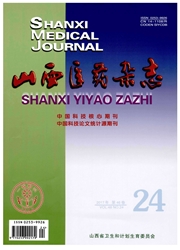

 中文摘要:
中文摘要:
目的评价呼气末正压通气对阻塞性睡眠呼吸暂停综合征(OSAS)肥胖患者全麻术中呼吸功能的影响。方法择期行悬雍垂腭咽成形术的OSAS患者40例,性别不限,年龄26—57岁,ASAⅠ或Ⅱ级,按照体重将患者分为2组(n=20):正常体重组(A组),BMI〈26kg/rn2;肥胖组(B组),BMI〉32kg/m2。静脉注射咪达唑仑、异丙酚、舒芬太尼和顺阿曲库铵麻醉诱导,气管插管后先行非呼气末正压通气60min,再行呼气末正压通气60min,PEEP为8cmH2O2维持PZTCO235—45mmHg和气道峰压〈28cmH2O。分别于气管插管后5min(T1)、60min(T2)和120min(T3)时记录胸肺顺应性(CL)和气道阻力(Raw)。于清醒状态未吸纯氧前(T0)和T1-3时,采集足背动脉血样进行血气分析,计算氧合指数(PaO2/FiO2)、呼吸指数(RI)和生理无效腔(VD/VT)。记录术后24h内不良反应的发生情况。结果与T0时比较,B组T1和T2时PaO2/FiO2降低,RI升高(P〈0.05);与T1时比较,B组rr3时Pa02/FiO2、CL升高,RI降低(P〈0.05);与A组比较,B组T1和T2时PaO2/FiO2和CL降低,T1-3时Raw,RI和VD/VT升高(P〈0.05)。两组患者术后24h内均未见心脑血管意外、气胸或肺水肿等不良反应的发生。结论呼气末正压通气(PEEP8cmH2O)可抑制OSAS肥胖患者全麻术中肺不张,改善气体交换和胸肺顺应性。
 英文摘要:
英文摘要:
Objective To investigate the effects of positive end expiratory pressure ventilation on respiratory function during general anesthesia in obese patients with obstructive sleep apnea syndrome (OSAS). Methods Forty ASA Ⅰ or Ⅱpatients aged 26-57 yr undergoing elective uvulo-palato-pharyngoplasty (UPPP) were divided into 2 body weight groups ( n = 20 each) : group A normal body weight patients- BMI 〈 26 kg/m2 and group B obese patients-BMI 〉 32 kg/m2 . Anesthesia was induced with midazolam, propofol and sufentanil. Tracheal intobation was facilitated with cis-atracurium. Anesthesia was maintained with 1.0% sevoflurane and continuotis infusion of propofol and remifentanil and intermittent iv boluses of cis-atracurium. All patients were mechanically ventilated, first without PEEP for 60 min followed by PEEP 8 cm H2O for 60 min. PET CO2 was maintained at 35-45 mm Hg and Peak airway pressure was maintained at 〈 28 cm H2O. Chest wall and lung compliance (CL) and airway resistance (Raw) were monitored and recorded at 5 min (T1), 60 min (T2 ) and 120 min (T3) after tracheal intubation. Arterial blood samples were taken before induction of anesthesia when the patients were awake breathing ambient air ( baseline, To ) and at T1 -T3 . PaO2/FiO2, respiratory index (RI) ( PA-a O2/PaO2 ) and physiologic dead space fraction (VD/VT) were calculated. Results PEEP 8 cm H20 significantly increased PaO2/FiO2, CL and decreased RI at T3 as compared with those at T1 in group B, but there was no significant change in PaO2/FiO2, CL and RI when PEEP 8 cm H20 was applied at T3 as compared with those at T1 in group A. No adverse reaction occurred in the two groups. Conclusion In obese patients with OSAS, PEEP 8 cm H2O can effectively prevent atelectasis and improve gas exchange and compliance.
 同期刊论文项目
同期刊论文项目
 同项目期刊论文
同项目期刊论文
 The effect of rhBMP-2 on pulmonary arterioles remodeling in endotoxin-induced acute lung injury in r
The effect of rhBMP-2 on pulmonary arterioles remodeling in endotoxin-induced acute lung injury in r Protective effects of bone marrow-derived endothelial progenitor cells and houttuynia cordata in lip
Protective effects of bone marrow-derived endothelial progenitor cells and houttuynia cordata in lip 期刊信息
期刊信息
